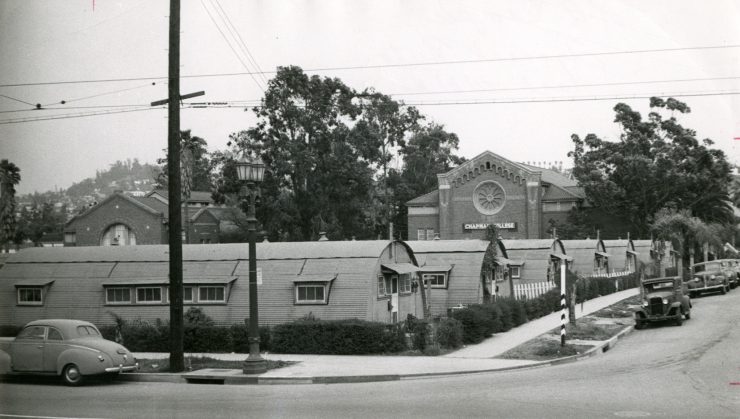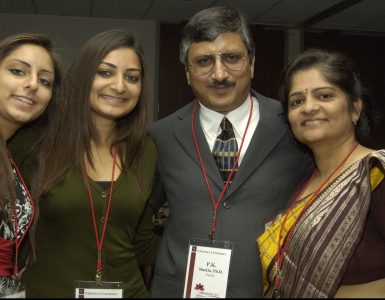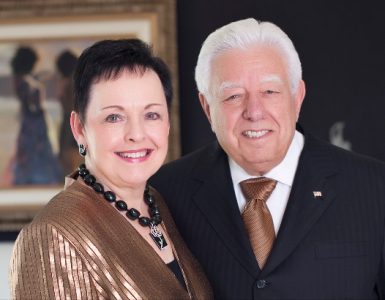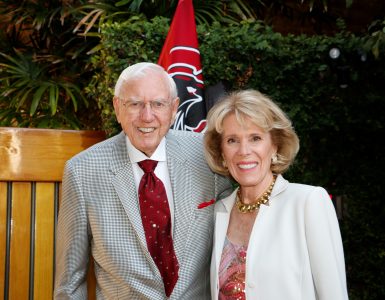From the Sunset bus window I see the glowing neon sign, Chapman College, on a North Vermont Avenue building. I pull the cord above my seat and step down from the bus in front of two rows of Quonset huts, home to a few faculty members and married students. Breathless and uncertain, I scurry toward the college quadrangle, little demons of fear pricking at my feet. Spotlights on the brick buildings poke bright fingers through tall shaggy-barked eucalyptus trees rustling in the warm evening breeze and shadow dancing on the lawn. A group of chattering coeds materializes at the far side of the quad, bound for the women’s dormitory. They gather me into their protective covey, and I sigh with relief.
In Tucson, Arizona our family attends the First Christian Church, (Disciples of Christ). My parents allowed me to attend Chapman College because of its affiliation with this denomination. For the past three days my sister, Marjorie, has helped me settle in at Chapman. I have just returned from Los Angeles Union Station, where I said goodbye to her. For the first time in my life I am on my own. Coming to this vast city, intimidating to a small-town girl of eighteen, marks a pivotal transition in my life.
Alone in my second-story dorm room that evening, I raise the window overlooking the quad. Elbows propped on the paint-cracked sill, hands on my cheeks, I listen to night sounds: a fountain splashing, wind rustling in trees, crickets calling, and the clang-clang of the Los Angeles Railway V Line streetcar, rumbling down Vermont Avenue. Chapman’s red brick, ivy-covered buildings surround the quadrangle, where four sidewalks converge at a fishpond and fountain. Students gather at the crescent-shaped benches encircling the pond to chat between classes. The fountain will become a symbol of my four-year metamorphosis.
For the welcoming ritual of the next few days I don a green frosh beanie and suffer the indignities meted out by lordly sophomores. In the weeks to come, as I adjust to new faces and schedules, the tide of my loneliness ebbs. And before long, a full-fledged member of this small cosmos, I make new friends among students and professors.
The greatest changes occur during my freshman year, and I still take pleasure in conjuring up those memories. In the first weeks I am caught up in a breathtaking whirlwind romance. A whimsical sort, my new boyfriend pins an orchid on my old green raincoat, and we stroll along Vermont in drizzling rain, feasting on soda crackers dipped into a can of cold Campbell’s mushroom soup. … With new friends I walk up Vermont Avenue and take the tree-lined road in Barnsdall Park. We celebrate my boyfriend’s birthday, explore Frank Lloyd Wright’s Hollyhock House, and indulge in tree climbing and impromptu dancing. …. Up the street at Los Angeles City College, friends and I sit on the grass and blow fluffy dandelions apart. We watch its seeds drift upward, like the soaring notes in the Bach Concerto in D Minor for two violins on a portable radio.
At Chapman our days are filled with classes, meetings, chapel, and convocation—sometimes we naughty shirkers cut it. We find time to read our mail and sip cokes at the student store. We also fit studying into our schedule. (At that time the school used the single subject plan—an immersion in one class for six weeks.)
Some of us work on campus to help pay our way through college. I serve as a waitress in the coed dining room managed by Chapman graduate, Tiny Piper. That job plunks me into the midst of an elite camaraderie. (During the summer I join other Chapman students to work at “Tiny Piper’s Cafeteria” on Santa Catalina Island, twenty-two miles off the California coast. A housemother supervises our conduct at the two-story dormitory behind the cafeteria.)
Our days on Chapman’s campus aren’t all work and no play. At night we females cheer our basketball team, attend sock hops, dress up for Thursday night dinners, serenade the men’s dorm, raise our voices in coed “sings” in the women’s lounge, and feast at dorm “spreads.” Taking a walk, hand in hand with the current heartthrob, always fits into our schedule.
We flock to student haunts close to campus. On Vermont Avenue, opposite the college, the bright Orange Julius devil grins and brandishes his pitchfork, tempting us to buy a cool orange drink; north of campus we browse at Burleigh’s Book Store; students and professors crowd around wooden tables at the Pepper Tree patio for donuts and coffee.
Amusements are not lacking in that pre-television era: hiking and horseback riding at Griffith Park, foreign movies at the Sunset Theater on Vermont; visiting Hollywood radio studios, the Pickwick Book Store, and the Vedanta Temple. South on Vermont is the Bimini Bowling Alley, and not far away on Kenmore Avenue, the Haig, a jam-packed bar where the inimitable Erroll Garner plays the piano, his fingers flying over the keyboard.
Sundaes, spaghetti, hamburgers, and french fries at the nearby Melrose Steak House, the Frosty Drive-in, or the Taft Building drug store in Hollywood supplement dining room fare. After attending church at the Wilshire Christian, as a special treat, we enjoy the luxury of a sandwich and chocolate soda at the Brown Derby.
Sometimes we take a bus to downtown Los Angeles. At Pershing Square we pass down-and-outers and soapbox haranguers on our way to visit Mike Lyman’s Grill, Manning’s Cafeteria, the Newsreel Theater, or exotic Clifton’s Cafeteria. We’ll climb to the giddy heights of the old Philharmonic Auditorium balcony for a concert, study at the Los Angeles Central Library, or stroll through Olvera Street to enjoy a taco feast in the atmosphere of Old Mexico.
For Saturday night dancing we trek to the Hollywood Palladium or the Aragon Ballroom in Ocean Park. Far more special are Chapman’s formal dances held at such posh establishments as the Hollywood Riviera Beach Club or the Palos Verdes Country Club. Those of us on the decorating crew will work most of the night before, but we’ll still find the energy to dance away the next.
On sunny weekends the gang may pile into someone’s old Ford—a few upper class men have cars in those postwar years—and tootle out Venice Boulevard past the old Helms Bakery to the beach for swimming and volleyball. In winter we play in the snow at Mt. Wilson.
After four years at Chapman, if professors deem we are ready to pursue our life goals, we may don a cap and gown. An English major, as well as a voice student and choir member, in my senior year I am honored when music director, John Browning—father of the noted pianist of the same name—asks me to give a joint recital with a violinist, and also to sing at the graduation ceremonies.
And then, after we march through the quad to “Pomp and Circumstance,” friends part, and life, real life, begins.
At 766 North Vermont Avenue between Marathon and Monroe Streets, no brick buildings around a fishpond, tall eucalyptus trees, nor lawns remain. The dorm windows through which we’d hear our dates call to us are but shattered memories.
But wait! There is a silver lining to this tale. Chapman alums now have even more reason to be proud of our alma mater. When we graduated from the North Vermont campus in 1950, the college had an enrollment of about 300 students. In 1954 Chapman College moved from Los Angeles to Orange, California. Today with an enrollment of 7,570, the school is now the prestigious Chapman University. Formerly renown for education, psychology, humanities, religious studies, and music, now Chapman is far more diverse, offering courses in economics, law, science, technology, performance, film and media arts, as well as advanced graduate degrees.
Hilarious or tearful, memories of Chapman College’s brick buildings and quad are burnished by time. The journey back to that campus can be taken only through the windows of our mind. Today, Chapman University in Orange, California, provides students with a multitude of windows of opportunity.
About the Author
A native of Tucson, Ariz., Mary Ellen (Zimmerman) Barnes graduated from Chapman College in 1950 with a bachelor of arts in English. Copies of four of her books are in Chapman University’s Leatherby Libraries: Forged by Fire: The Devastation and Renewal of a Mountain Community; The Road to Mount Lemmon: A Father, A Family, and the Making of Summerhaven; Teresa and the Cowboy: Un Cuento de Amor Tucsonense; and Peregrine.
Learn more about Mary Ellen by visiting her website »
Photo at top: Quonset huts on Chapman College’s North Vermont Avenue campus in 1946.





I graduated in 1953, and all this sound mighty familiar. I worked at Burleigh’s Book Store on Vermont Ave. and one summer worked at the L.A. County Fair when Tiny Piper ran the food concession. I cleared tables and washed dishes. I was a English major also, and I enjoyed Frank Gay’s classes which I shared with Darwin Mann and Ed Pollard (three of us in the upper division classes). A life-changing experience for me, and I am so grateful.
Hi Skip, thanks for sharing your experience as well! It’s really exciting to think about the history and hear stories of the days Chapman was in LA. We’ll pass along your comment to Mary Ellen.
Thank you for writing this article! I love hearing about the history of Chapman. It’s energizing to hear about the progress and makes me think about how much more is possible in the future.